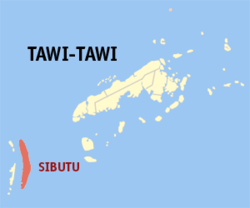Sibutu
| Sibutu | |
|---|---|
| Municipality | |
| Municipality of Sibutu | |
|
| |
 Map of Tawi-Tawi with Sibutu highlighted | |
.svg.png) Sibutu Location within the Philippines | |
| Coordinates: 4°51′N 119°28′E / 4.85°N 119.47°ECoordinates: 4°51′N 119°28′E / 4.85°N 119.47°E | |
| Country |
|
| Region | Autonomous Region in Muslim Mindanao (ARMM) |
| Province | Tawi-Tawi |
| District | Lone District |
| Founded | October 21, 2006 |
| Barangays | 16 (see Barangays) |
| Government [1] | |
| • Type | Sangguniang Bayan |
| • Mayor | Kuyoh Pajiji |
| • Electorate | 15,399 voters (2016) |
| Area [2] | |
| • Total | 285.32 km2 (110.16 sq mi) |
| Population (2015 census)[3] | |
| • Total | 30,387 |
| • Density | 110/km2 (280/sq mi) |
| Time zone | UTC+8 (PST) |
| ZIP code | 7510 |
| PSGC | 157011000 |
| IDD : area code | +63 (0)68 |
| Climate type | Tropical climate |
| Revenue (₱) | 68,642,701.33 (2016) |
| Native languages |
Sama language Tagalog |
Sibutu, officially the Municipality of Sibutu, is a class municipality in the province of Tawi-Tawi, Philippines. According to the 2015 census, it has a population of 30,387 people.[3]
It lies about 14 kilometres (8.7 mi) east of the coast of Sabah, Malaysia. The municipality covers the main island of Sibutu as well as four small uninhabited islands 3.5 to 6 kilometres (2.2 to 3.7 mi) south of the main island, which are, from north to south: Sicolan Calch Island, Sicolan Island, Sicolan Islet, and Saluag Island, the latter being the southernmost island of the Philippines.
Sibutu Island has an area is 109 square kilometres (42 sq mi). It is an important site for nature conservation.[4]
History
Due to an administrative error in the Treaty of Paris, while the remainder of the Philippines was ceded to the United States, Sibutu and Cagayán de Sulu were retained under Spanish Sovereignty until they were formally ceded to the United States upon the ratification of the Treaty of Washington on March 23, 1901.
The municipality was created out of Sitangkai, Tawi-Tawi, by virtue of Muslim Mindanao Autonomy Act No. 197,[5] which was subsequently ratified in a plebiscite held on October 21, 2006.[6]
Barangays
Sibutu is politically subdivided into 16 barangays.
- Ambutong Sapal
- Datu Amilhamja Jaafar
- Hadji Imam Bidin
- Hadji Mohtar Sulayman
- Hadji Taha
- Imam Hadji Mohammad
- Nunukan
- Sheik Makdum
- Sibutu (Poblacion)
- Talisay
- Tandu Banak
- Tandu Owak
- Taungoh
- Tongehat
- Tongsibalo
- Ungus-ungus
Demographics
| Population census of Sibutu | ||
|---|---|---|
| Year | Pop. | ±% p.a. |
| 2007 | 35,377 | — |
| 2010 | 28,532 | −7.53% |
| 2015 | 30,387 | +1.21% |
| Source: Philippine Statistics Authority[3][7][8][9] | ||
References
- ↑ "Municipality". Quezon City, Philippines: Department of the Interior and Local Government. Retrieved 31 May 2013.
- ↑ "Province: Tawi-tawi". PSGC Interactive. Quezon City, Philippines: Philippine Statistics Authority. Retrieved 12 November 2016.
- 1 2 3 Census of Population (2015). "ARMM – Autonomous Region in Muslim Mindanao". Total Population by Province, City, Municipality and Barangay. PSA. Retrieved 20 June 2016.
- ↑ Danielsen, Finn & Treadaway, Colin G., 2004: Priority conservation areas for butterflies (Lepidoptera: Rhopalocera) in the Philippine Islands. Animal Conservation, 7, 79-92.
- ↑ "Muslim Mindanao Autonomy Act No. 197; An Act Creating the Municipality of Sibutu in the Province of Tawi-Tawi, and for Other Purposes" (PDF). Regional Legislative Assembly, Autonomous Region in Muslim Mindanao. Retrieved 27 January 2016.
- ↑ MMA Act No. 197 : An Act Creating the Municipality of Sibutu in the Province of Tawi-Tawi Archived 2014-02-26 at the Wayback Machine.
- ↑ Census of Population and Housing (2010). "ARMM – Autonomous Region in Muslim Mindanao". Total Population by Province, City, Municipality and Barangay. NSO. Retrieved 29 June 2016.
- ↑ Censuses of Population (1903–2007). "ARMM – Autonomous Region in Muslim Mindanao". Table 1. Population Enumerated in Various Censuses by Province/Highly Urbanized City: 1903 to 2007. NSO.
- ↑ "Province of Tawi‑tawi". Municipality Population Data. Local Water Utilities Administration Research Division. Retrieved 17 December 2016.
External links
- Landsat images
- NSCB: newly created provinces, municipalities, barangays, converted city Accessed on March 9, 2006.